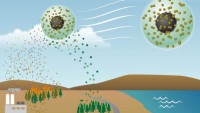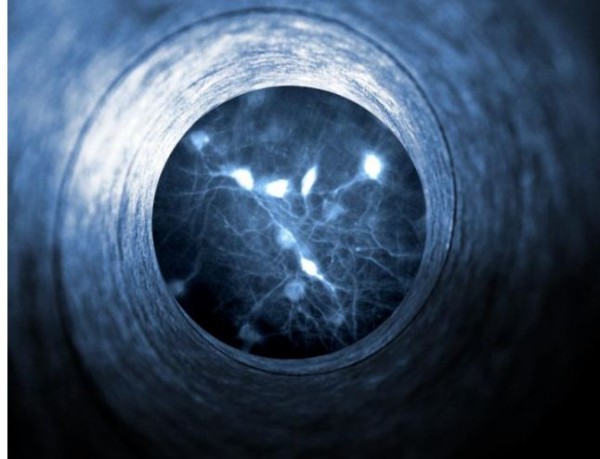Scientists Uncover More about how Sex-Hormone-Sensitive Neurons Trigger Attraction
| Arthur Dominic Villasanta | | Jan 31, 2017 10:40 AM EST |
(Photo : Jenna McHenry, PhD, UNC School of Medicine) These are neurotensin cells in the medial preoptic brain area seen through a 2-photon microscope attached to a live mouse.
An important clue about the sex-hormone-sensitive neurons responsible for triggering a person's attraction to the opposite sex has been discovered by a new study from the from the University of North Carolina School of Medicine.
Using advanced deep brain imaging techniques and optogenetics, UNC scientists found that a small cluster of sex-hormone-sensitive neurons in the mouse hypothalamus are specialized for inducing mice to pay more attention to the opposite sex and triggering an attraction.
Like Us on Facebook
This study identified a hormone-sensitive circuit in the brain that controls social motivation in female mice. It was led by Garret D. Stuber, PhD, associate professor of psychiatry and cell biology and physiology, and Jenna A. McHenry, PhD, a postdoctoral research associate in Stuber's lab.
The findings reported in Nature Neuroscience illuminate the neural roots of opposite-sex social behavior in mammals. They might also be relevant to certain psychiatric illnesses.
"These neurons essentially take sensory and hormonal signals and translate them into motivated social behavior," said Stuber, who is also a member of the UNC Neuroscience Center.
"These neural circuits that bridge social and reward processing should also provide important insights for disorders that impair social motivation," said McHenry, first author of the paper.
In the study, Stuber and colleagues examined the medial preoptic area (mPOA) of the brain. This clump of neurons sits within the hypothalamus, an evolutionarily ancient structure at the bottom-center of the brain.
Prior research showed that the mPOA is important for social and reproductive behavior in all vertebrate species studied from fish to human. But it's been unclear whether this area drives social motivation through circuit connections with reward systems in the brain.
Researchers focused on one of the mPOA's major connections through which it sends neural signals to another brain structure called the ventral tegmental area (VTA), which is known to be a powerful contributor in motivating behavior and the release of the neurotransmitter dopamine.
"On the whole, the data suggest that these mPOA neurons help drive social attraction toward a potential mate," said Stuber.
Stuber's team plans to follow up by applying similar imaging and optogenetics methods to the workings of the VTA neurons downstream from the mPOA.
Aside from its basic neuroscience impact, the research has implications for anxiety, depression and related disorders, which can be triggered or worsened in some women by shifts in hormone levels.
"While hormone-related changes in motivation are important for mating or maternal behavior in female mice, some atypical hormonal changes in women appear to underlie reproductive mood disorders, such as postpartum depression," said McHenry, who is also a Fellow on the Postdoctoral Reproductive Mood Disorders Training Fellowship at UNC.
Tagssex-hormone-sensitive neurons, University of North Carolina School of MedicineUniversity of North Carolina School of Medicine, Garret D. Stuber, Jenna A. McHenry, neurons, medial preoptic area, hypothalamus, mPOA, ventral tegmental area, optogenetics
©2015 Chinatopix All rights reserved. Do not reproduce without permission
 Only Three Student Teams Manage to Race in SpaceX’s First Hyperloop Competition
Only Three Student Teams Manage to Race in SpaceX’s First Hyperloop Competition Some Pollutants can Travel Around the World and Increase Lung Cancer Risks
Some Pollutants can Travel Around the World and Increase Lung Cancer Risks Conspiracy Nuts Claim World will End on Feb. 16 in a Comet Strike
Conspiracy Nuts Claim World will End on Feb. 16 in a Comet Strike There's no Relation between Inheriting Tallness and Better Living Standards, says Study
There's no Relation between Inheriting Tallness and Better Living Standards, says Study
EDITOR'S PICKS
-

Did the Trump administration just announce plans for a trade war with ‘hostile’ China and Russia?
-

US Senate passes Taiwan travel bill slammed by China
-

As Yan Sihong’s family grieves, here are other Chinese students who went missing abroad. Some have never been found
-

Beijing blasts Western critics who ‘smear China’ with the term sharp power
-

China Envoy Seeks to Defuse Tensions With U.S. as a Trade War Brews
-

Singapore's Deputy PM Provides Bitcoin Vote of Confidence Amid China's Blanket Bans
-

China warns investors over risks in overseas virtual currency trading
-

Chinese government most trustworthy: survey
-

Kashima Antlers On Course For Back-To-Back Titles
MOST POPULAR
LATEST NEWS
Zhou Yongkang: China's Former Security Chief Sentenced to Life in Prison

China's former Chief of the Ministry of Public Security, Zhou Yongkang, has been given a life sentence after he was found guilty of abusing his office, bribery and deliberately ... Full Article
TRENDING STORY

China Pork Prices Expected to Stabilize As The Supplies Recover

Elephone P9000 Smartphone is now on Sale on Amazon India

There's a Big Chance Cliffhangers Won't Still Be Resolved When Grey's Anatomy Season 13 Returns

Supreme Court Ruled on Samsung vs Apple Dispute for Patent Infringement

Microsoft Surface Pro 5 Rumors and Release Date: What is the Latest?










